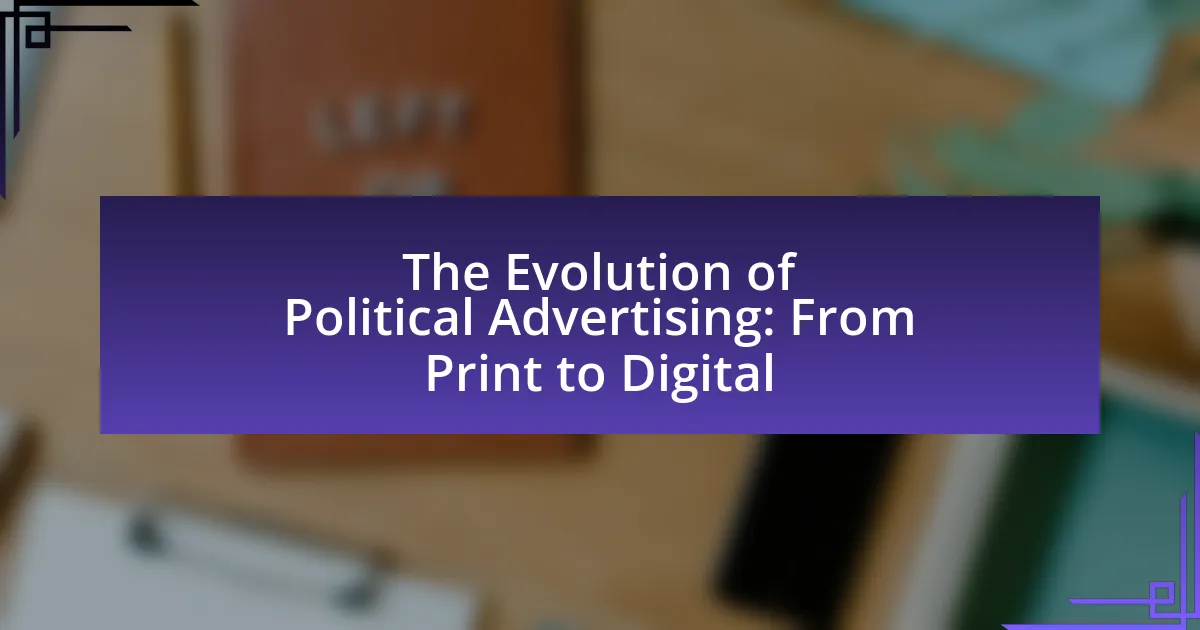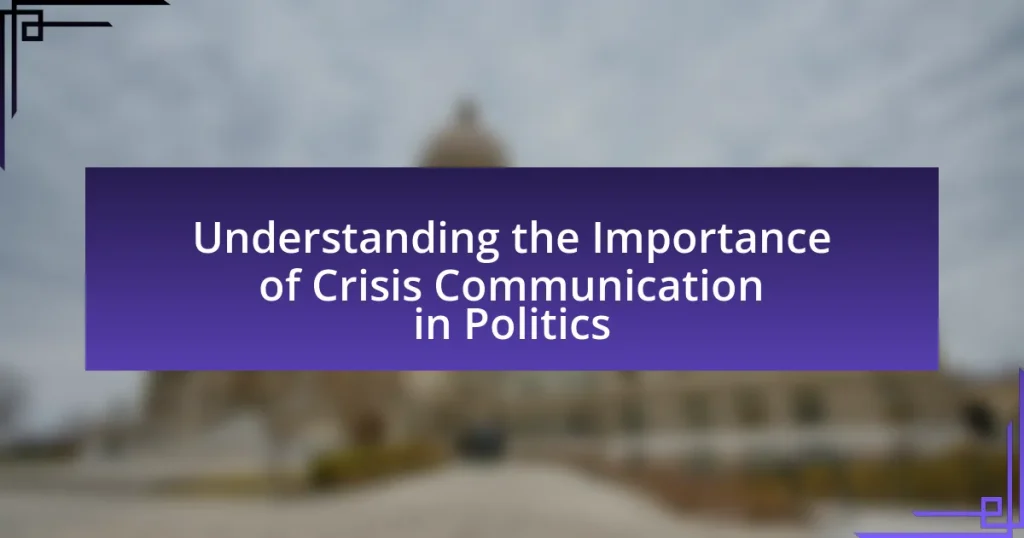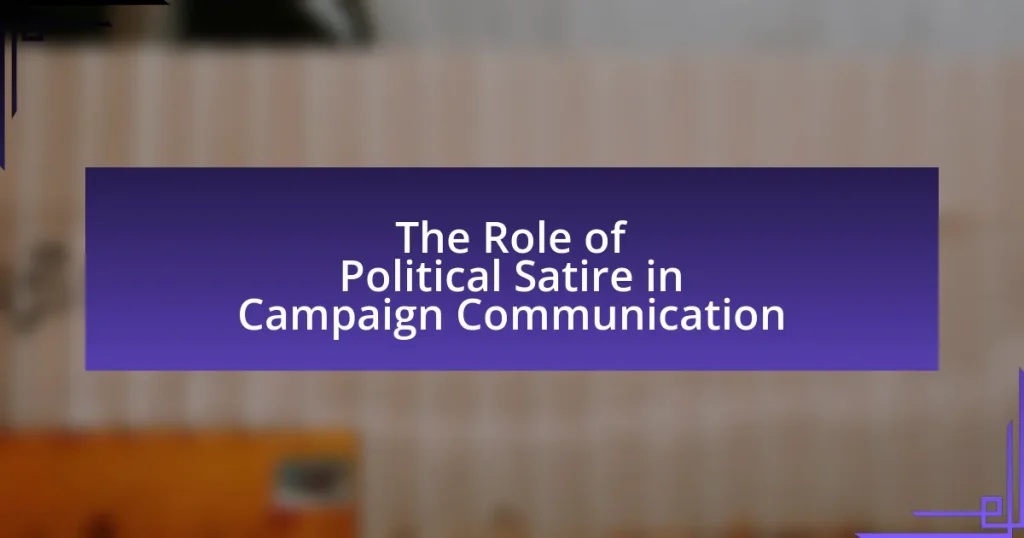The article examines the evolution of political advertising, tracing its development from traditional print media to contemporary digital platforms. It highlights key milestones, such as the transition from pamphlets and newspapers in the 19th century to the impactful use of radio and television in the mid-20th century, exemplified by the Kennedy-Nixon debates. The rise of the internet and social media in the 21st century has transformed advertising strategies, enabling targeted messaging and data-driven approaches that enhance voter engagement. Additionally, the article discusses the ethical considerations, regulations, and best practices that shape modern political advertising, emphasizing the importance of transparency and audience understanding in effective campaign strategies.
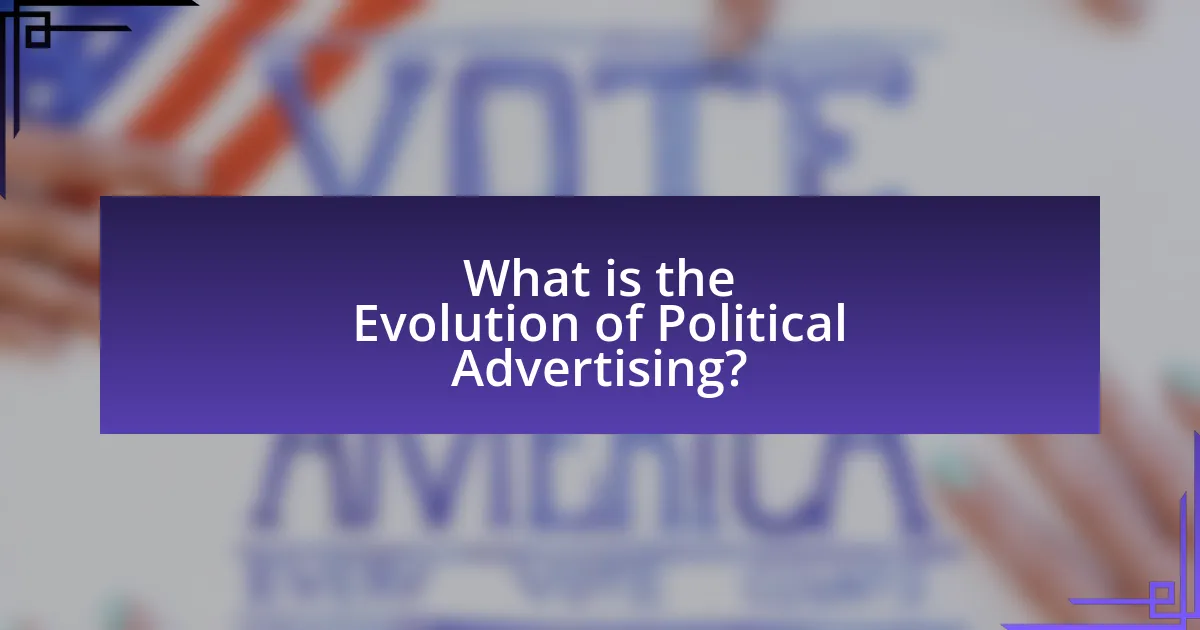
What is the Evolution of Political Advertising?
The evolution of political advertising has transitioned from traditional print media to digital platforms. Initially, political advertising relied heavily on newspapers, pamphlets, and posters, which were the primary means of reaching voters in the 19th and early 20th centuries. With the advent of radio and television in the mid-20th century, political campaigns began utilizing these mediums to broadcast messages more widely and effectively, exemplified by the famous 1960 Kennedy-Nixon debates that showcased the power of televised advertising.
As technology advanced, the rise of the internet in the late 20th century marked a significant shift in political advertising strategies. Campaigns began to leverage websites, email marketing, and social media platforms to engage voters directly and target specific demographics. The 2008 Obama campaign is often cited as a pivotal moment in this evolution, utilizing social media and data analytics to mobilize supporters and tailor messages.
Today, political advertising continues to evolve with the increasing use of digital tools, including programmatic advertising and targeted ads on platforms like Facebook and Google, allowing campaigns to reach voters with unprecedented precision. This shift reflects a broader trend towards data-driven strategies in political communication, fundamentally changing how candidates connect with the electorate.
How has political advertising changed over time?
Political advertising has evolved significantly from traditional print media to digital platforms. Initially, political campaigns relied heavily on print advertisements, posters, and pamphlets to reach voters, with notable examples like the use of newspapers in the 19th century. As technology advanced, radio and television became dominant mediums in the mid-20th century, allowing for more dynamic and engaging content, exemplified by the Kennedy-Nixon debates in 1960, which highlighted the impact of visual presentation on public perception.
In the 21st century, the rise of the internet and social media has transformed political advertising, enabling targeted campaigns that leverage data analytics to reach specific demographics. For instance, the 2008 Obama campaign effectively utilized social media platforms to mobilize voters and engage with them directly, marking a shift towards more interactive and personalized advertising strategies. This transition reflects a broader trend where political advertising has become more immediate, data-driven, and responsive to voter behavior, illustrating the profound impact of technological advancements on the political landscape.
What were the key milestones in the history of political advertising?
The key milestones in the history of political advertising include the introduction of printed pamphlets in the 18th century, the use of radio and television in the mid-20th century, and the rise of digital advertising in the 21st century. Printed pamphlets emerged as a means for candidates to communicate their messages directly to voters, significantly influencing public opinion during elections. The advent of radio in the 1920s allowed candidates like Franklin D. Roosevelt to reach a broader audience, while television became a pivotal platform in the 1960s, exemplified by John F. Kennedy’s successful campaign that utilized televised debates. In the 2000s, the internet transformed political advertising through targeted social media campaigns, enabling candidates to engage with voters on a personal level and analyze data for strategic outreach. These milestones reflect the evolving methods of communication and engagement in political campaigns throughout history.
How did technological advancements influence political advertising?
Technological advancements significantly transformed political advertising by enabling targeted messaging and real-time engagement with voters. The rise of digital platforms, such as social media and search engines, allowed political campaigns to analyze voter data and tailor advertisements to specific demographics, increasing the effectiveness of their outreach. For instance, during the 2016 U.S. presidential election, campaigns utilized data analytics to micro-target ads, resulting in a more personalized voter experience and higher engagement rates. This shift from traditional media, like print and television, to digital channels marked a pivotal change in how political messages are disseminated and consumed, ultimately reshaping the landscape of political communication.
Why is understanding the evolution of political advertising important?
Understanding the evolution of political advertising is important because it reveals how strategies and technologies have shaped voter engagement and influence over time. Political advertising has transitioned from traditional print media to digital platforms, reflecting changes in communication methods and audience behavior. For instance, the rise of social media has allowed for targeted advertising, enabling campaigns to reach specific demographics more effectively than ever before. This shift is evidenced by the 2016 U.S. presidential election, where digital ad spending surpassed traditional media for the first time, highlighting the growing significance of online platforms in shaping public opinion and electoral outcomes.
What impact does historical context have on current political advertising strategies?
Historical context significantly shapes current political advertising strategies by influencing the methods, messages, and mediums used. For instance, the transition from print to digital advertising reflects historical shifts in technology and communication, such as the rise of television in the mid-20th century, which changed how campaigns reached voters. The effectiveness of targeted messaging in digital platforms today can be traced back to earlier strategies that utilized demographic data from print media. Additionally, historical events, such as the Watergate scandal, have led to increased scrutiny and regulation of political advertising, impacting how campaigns craft their messages to maintain credibility. This evolution demonstrates that understanding past advertising practices and societal responses informs contemporary strategies, ensuring they resonate with current voter sentiments and technological capabilities.
How can lessons from the past inform future political campaigns?
Lessons from the past can inform future political campaigns by analyzing historical successes and failures in messaging, strategy, and voter engagement. For instance, the 1960 Kennedy-Nixon debates highlighted the importance of television as a medium, demonstrating that candidates who effectively utilized visual media could significantly influence public perception and voter turnout. Additionally, the 2008 Obama campaign leveraged social media to mobilize younger voters, showcasing the effectiveness of digital platforms in reaching specific demographics. These examples illustrate that understanding past campaign dynamics, such as media impact and audience targeting, can guide future strategies for maximizing voter engagement and campaign effectiveness.
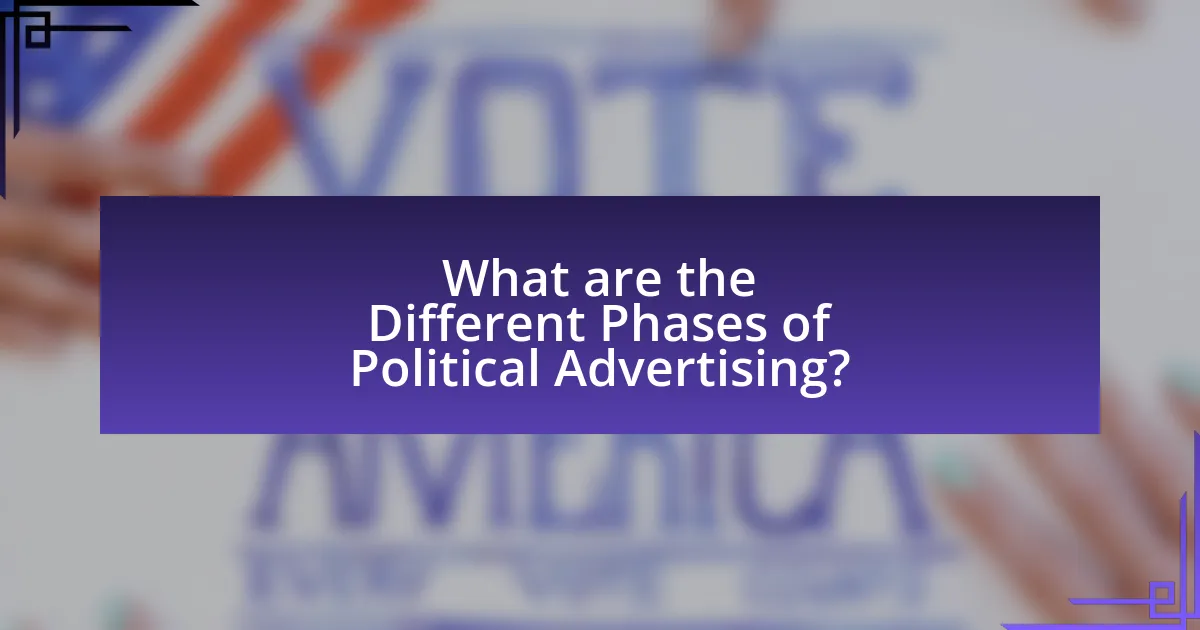
What are the Different Phases of Political Advertising?
The different phases of political advertising include the pre-campaign phase, the campaign phase, and the post-campaign phase. In the pre-campaign phase, candidates build their brand and establish their message through various media, often utilizing print and broadcast advertisements to create awareness. During the campaign phase, political advertising intensifies, focusing on targeted messaging through television, radio, online platforms, and social media to engage voters and influence public opinion. Finally, the post-campaign phase involves analyzing the effectiveness of the advertising strategies used, assessing voter response, and preparing for future elections. This structured approach to political advertising has evolved significantly, particularly with the rise of digital platforms, which allow for more precise targeting and real-time feedback.
What characterized the print era of political advertising?
The print era of political advertising was characterized by the use of newspapers, pamphlets, and posters to disseminate political messages. This period, particularly prominent from the 19th century to the early 20th century, relied heavily on printed materials to reach a broad audience. Political candidates utilized these mediums to convey their platforms, engage voters, and influence public opinion, often employing persuasive language and imagery to capture attention. The effectiveness of print advertising is evidenced by its role in pivotal elections, such as the 1828 presidential campaign of Andrew Jackson, where pamphlets and posters significantly contributed to his grassroots support and eventual victory.
How did newspapers and pamphlets shape political messaging?
Newspapers and pamphlets significantly shaped political messaging by providing a platform for the dissemination of political ideas and information to a broad audience. These print media allowed politicians and activists to communicate their messages directly to the public, influencing public opinion and mobilizing support. For instance, during the American Revolution, pamphlets like Thomas Paine’s “Common Sense” effectively rallied support for independence by articulating the case against British rule in accessible language. This accessibility and reach enabled political messages to penetrate various social classes, fostering informed citizenry and engagement in political discourse.
What were the limitations of print advertising in politics?
Print advertising in politics had several limitations, including restricted audience reach, lack of interactivity, and delayed feedback. The audience reach was limited by geographic distribution and the demographics of print media consumers, often excluding younger voters who preferred digital platforms. Additionally, print advertisements lacked interactivity, preventing immediate engagement or response from the audience, which is crucial in political campaigns. Furthermore, the feedback loop was slow; campaign teams could not quickly gauge public reaction or adjust strategies based on real-time data, unlike digital advertising, which allows for instant analytics and modifications. These limitations hindered the effectiveness of print advertising in conveying political messages and mobilizing voters.
How did the rise of broadcast media transform political advertising?
The rise of broadcast media transformed political advertising by enabling candidates to reach a larger audience through television and radio, significantly increasing the visibility and impact of their campaigns. This shift allowed for the creation of more dynamic and emotionally engaging advertisements, which could convey messages quickly and effectively to millions of viewers simultaneously. For instance, the 1960 presidential debate between John F. Kennedy and Richard Nixon highlighted the power of televised communication, as Kennedy’s confident appearance contrasted with Nixon’s less favorable image, influencing public perception and voter behavior. Consequently, broadcast media became a crucial tool for shaping political narratives and mobilizing voters, fundamentally changing the strategies employed in political advertising.
What role did television play in political campaigns?
Television played a pivotal role in political campaigns by transforming how candidates communicate with voters. It allowed for direct visual engagement, enabling candidates to convey their messages, personalities, and policies more effectively than print media. The first televised presidential debate in 1960 between John F. Kennedy and Richard Nixon exemplified this shift; Kennedy’s confident appearance contrasted with Nixon’s less favorable image, influencing public perception and voter behavior. Studies indicate that candidates who effectively utilized television advertising gained significant advantages in voter recognition and support, highlighting television’s impact on electoral outcomes.
How did radio advertising influence voter perceptions?
Radio advertising significantly influenced voter perceptions by providing direct and immediate communication from candidates to the electorate. This medium allowed political messages to reach a broad audience quickly, shaping public opinion through emotional appeals and persuasive rhetoric. For instance, during the 1930s and 1940s, radio became a crucial tool for political campaigns, exemplified by Franklin D. Roosevelt’s “Fireside Chats,” which fostered a sense of connection and trust between the president and the public. Studies indicate that radio advertising increased voter engagement and awareness, as it enabled candidates to present their platforms in a relatable manner, thus altering how voters perceived their choices in elections.
What are the defining features of digital political advertising?
Digital political advertising is characterized by targeted messaging, data analytics, and interactive engagement. Targeted messaging allows campaigns to reach specific demographics based on user data, enhancing the relevance of advertisements. Data analytics enables political advertisers to measure the effectiveness of their campaigns in real-time, allowing for adjustments based on audience response. Interactive engagement fosters direct communication between candidates and voters, often through social media platforms, which can increase voter participation and feedback. These features collectively enhance the efficiency and impact of political campaigns in the digital landscape.
How has social media changed the landscape of political communication?
Social media has fundamentally transformed political communication by enabling direct interaction between politicians and the electorate. This shift allows candidates to bypass traditional media gatekeepers, facilitating real-time engagement and feedback. For instance, platforms like Twitter and Facebook have been used extensively during elections, with 2016 U.S. presidential candidates utilizing social media to reach millions of voters directly, resulting in a significant increase in voter engagement and mobilization. According to a Pew Research Center study, 69% of adults in the U.S. reported using social media for news, highlighting its role as a primary source of political information. This evolution has led to a more participatory political landscape, where public opinion can be shaped and influenced rapidly through viral content and targeted advertising.
What tools and platforms are most effective for digital political advertising?
The most effective tools and platforms for digital political advertising include social media networks, programmatic advertising platforms, and email marketing services. Social media networks like Facebook and Twitter allow targeted advertising based on user demographics and interests, which is crucial for reaching specific voter segments. Programmatic advertising platforms, such as Google Ads and The Trade Desk, enable real-time bidding for ad placements, optimizing reach and cost-effectiveness. Email marketing services, like Mailchimp and Constant Contact, facilitate direct communication with supporters and potential voters, enhancing engagement and mobilization efforts. These platforms have been shown to significantly increase voter outreach and campaign effectiveness, as evidenced by the 2020 U.S. presidential election, where digital advertising expenditures reached over $1 billion, highlighting the growing importance of these tools in modern political campaigns.

What are the Key Strategies in Political Advertising Today?
Key strategies in political advertising today include targeted digital marketing, data analytics, and social media engagement. Targeted digital marketing allows campaigns to reach specific demographics through platforms like Facebook and Google, optimizing ad spend and increasing voter outreach. Data analytics plays a crucial role by enabling campaigns to analyze voter behavior and preferences, tailoring messages to resonate with different segments. Social media engagement fosters direct communication between candidates and voters, enhancing transparency and building community support. According to a 2020 Pew Research study, 69% of Americans reported using social media for political news, highlighting its significance in modern political advertising.
How do political campaigns utilize data analytics in advertising?
Political campaigns utilize data analytics in advertising by analyzing voter demographics, preferences, and behaviors to tailor their messaging and outreach strategies. This targeted approach allows campaigns to identify key voter segments, optimize ad placements, and measure the effectiveness of their advertising efforts. For instance, during the 2012 U.S. presidential election, the Obama campaign famously used data analytics to segment voters and deliver personalized messages, resulting in a reported increase in voter turnout by 5% among targeted demographics. This demonstrates how data-driven strategies can significantly enhance the impact of political advertising.
What types of data are most valuable for targeting voters?
Demographic data, behavioral data, and psychographic data are the most valuable types of data for targeting voters. Demographic data includes age, gender, income, and education level, which help campaigns identify key voter segments. Behavioral data, such as voting history and engagement with political content, allows campaigns to understand voter preferences and likelihood to vote. Psychographic data, which encompasses values, interests, and lifestyle choices, provides deeper insights into voter motivations and can guide messaging strategies. Research indicates that campaigns utilizing these data types can increase voter engagement and improve targeting effectiveness, as evidenced by the success of data-driven strategies in recent elections.
How does data-driven advertising enhance campaign effectiveness?
Data-driven advertising enhances campaign effectiveness by enabling precise targeting and personalization of messages to specific audience segments. This approach allows advertisers to analyze consumer behavior, preferences, and demographics, leading to more relevant ad placements. For instance, a study by the Interactive Advertising Bureau found that targeted ads can increase conversion rates by up to 50%. By leveraging data analytics, campaigns can optimize ad spend, improve engagement rates, and ultimately drive higher return on investment.
What ethical considerations arise in modern political advertising?
Ethical considerations in modern political advertising include misinformation, manipulation of emotions, and the exploitation of personal data. Misinformation can mislead voters, as seen in the 2016 U.S. presidential election where false narratives spread rapidly online, influencing public perception. Emotional manipulation is prevalent, with ads designed to evoke fear or anger, which can distort rational decision-making. Additionally, the use of personal data for targeted advertising raises privacy concerns, as individuals may not be aware of how their information is being used to influence their political choices. These factors highlight the need for ethical standards in political advertising to ensure transparency and accountability.
How do misinformation and disinformation impact political campaigns?
Misinformation and disinformation significantly undermine the integrity of political campaigns by distorting public perception and influencing voter behavior. Misinformation refers to false or misleading information shared without harmful intent, while disinformation involves the deliberate spread of falsehoods to deceive. Studies have shown that misinformation can lead to increased polarization among voters, as individuals may align more closely with distorted narratives that confirm their biases. For instance, a 2020 study published in the journal “Nature” found that exposure to false information during the U.S. presidential election led to a measurable impact on voter opinions and decisions. Furthermore, disinformation campaigns, often facilitated by social media platforms, can amplify false narratives rapidly, reaching millions of users and creating a false consensus around misleading claims. This manipulation of information can sway undecided voters and solidify support for candidates based on inaccuracies, ultimately affecting election outcomes.
What regulations exist to govern political advertising practices?
Regulations governing political advertising practices include the Federal Election Commission (FEC) rules in the United States, which require disclosure of funding sources for political ads and prohibit false statements about candidates. The Bipartisan Campaign Reform Act (BCRA) also restricts the timing and content of political advertisements, particularly those funded by corporations and unions. Additionally, many states have their own laws that further regulate political advertising, including requirements for disclaimers and transparency in funding. These regulations aim to ensure fair practices and accountability in political communication, as evidenced by the enforcement actions taken by the FEC against violations, which underscore the importance of compliance in maintaining electoral integrity.
What best practices should political campaigns follow in advertising?
Political campaigns should prioritize transparency, targeting, and message consistency in their advertising efforts. Transparency involves clearly disclosing funding sources and affiliations, which builds trust with voters; for instance, the Federal Election Commission mandates that political ads identify their sponsors. Targeting ensures that campaigns reach specific demographics effectively, utilizing data analytics to tailor messages to different voter segments, as evidenced by the success of micro-targeting strategies in the 2012 Obama campaign. Message consistency across various platforms reinforces brand identity and helps voters easily recognize and recall campaign themes, which is crucial in a fragmented media landscape.
How can campaigns effectively engage with their target audience?
Campaigns can effectively engage with their target audience by utilizing data-driven strategies to tailor messages and platforms to specific demographics. For instance, leveraging analytics allows campaigns to understand voter preferences and behaviors, enabling them to create personalized content that resonates with their audience. Research indicates that targeted advertising can increase engagement rates by up to 50%, demonstrating the effectiveness of this approach. Additionally, employing social media platforms, which are used by over 70% of the population, allows campaigns to interact directly with voters, fostering a sense of community and involvement.
What are the common pitfalls to avoid in political advertising?
Common pitfalls to avoid in political advertising include misleading information, lack of target audience understanding, and failure to comply with regulations. Misleading information can damage credibility and lead to backlash, as seen in various campaigns where false claims were debunked, resulting in public distrust. Not understanding the target audience can lead to ineffective messaging; for instance, campaigns that fail to resonate with key demographics often see lower engagement and support. Additionally, non-compliance with advertising regulations, such as failing to disclose funding sources, can result in legal consequences and tarnish a candidate’s reputation. These pitfalls highlight the importance of accuracy, audience insight, and adherence to legal standards in political advertising.
